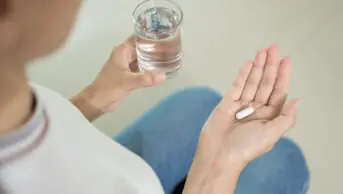This content was published in 2012. We do not recommend that you take any clinical decisions based on this information without first ensuring you have checked the latest guidance.
Palsy means paralysis. Bell’s palsy is a condition in which the inner ear becomes inflamed, resulting in pressure on, and even damage to, the facial nerve (see Panel) and causing facial paralysis.
The condition often presents suddenly, without warning, and can develop over a number of hours, peaking at 72 hours. The paralysis is usually restricted to one side of the face and may be partial or complete. Sometimes this is accompanied by a drooping of the affected side of the face, depending on the severity of nerve damage. Cognitive functioning and other physical abilities are not impaired. Other main symptoms include:
- Pain (which can be severe) in the inner ear during (and also in the days before) the onset of paralysis
- Impaired or altered sense of taste
- Sensitivity to loud noise
- A dry eye (because the person cannot blink or voluntarily close his or her eye properly)
- Difficulty eating (due to loss of control of one side of the lips and mouth) — food may get trapped in some areas and there may be involuntary drooling
- Difficulty speaking clearly, particularly with pronouncing letters such as B and P
Facial nerve
The facial nerve is the seventh cranial nerve. Each nerve runs from the brain just under the ear and splits into several branches. The facial nerve has a number of functions, with both sensory and motor components. It supplies the muscles of facial expression and the muscles used to close the eyes. It innervates the lacrimal, submandibular, and sublingual glands, as well as the mucous membranes of the nasopharynx, and the hard and soft palates. It is responsible for taste from part of the tongue and the hard and soft palates. The facial nerve is also responsible for general sensation from the skin of the ear.
Bell’s palsy is relatively rare — only one in 5,000 people develop it. Statistics show little discrepancy between incidence in males and females and in different races. Research suggests that those aged between 15 and 45 years, however, have an increased risk of developing the condition, as do pregnant women. In addition, there appears to be a higher incidence of Bell’s palsy in winter.
Causes and diagnosis
Bell’s palsy is idiopathic. It has not yet been established why the inner ear becomes inflamed but links have been made with viral infections (including herpes simplex and varicella zoster), as well as a weak immune system and stress.
There are a number of causes of acute facial paralysis but Bell’s palsy is the most common. Bell’s palsy is diagnosed by exclusion. A doctor will examine the patient and ask him or her to perform a range of facial movements, such as closing the eyes, puckering the lips, raising the eyebrows and smiling.
To eliminate other possible causes of facial palsy, the doctor may also request that the patient is tested for Lyme disease, diabetes, sarcoidosis and HIV. In addition, imaging (eg, magnetic resonance imaging and computed tomography) may be required to rule out potential causes such as tumours. Finally, a doctor may refer the patient to an ear, nose and throat specialist and arrange for electromyography to detect the location and extent of the nerve damage.
Treatment
In order for the patient to recover, the pressure on the nerve must be reduced. Research suggests that this can be achieved using a steroid or a steroid plus an antiviral.1,2
Treatment with a steroid can improve chances of a full recovery because it helps to reduce inflammation. Recent studies have shown that prednisolone is an effective agent and that it is best given within 72 hours of the appearance of symptoms.3,4 This is usually prescribed twice daily for 10 days.
Taking prednisolone after food can decrease the chance of gastrointestinal side effects such as nausea. Patients experiencing mood changes (eg, anxiety or depression) or other troublesome side effects should be advised to see their GP immediately.
The benefit of steroid use for Bell’s palsy in pregnancy versus the risk to the fetus is debatable and something for individual patients to discuss with their prescriber.
Because there is some evidence that Bell’s palsy is linked to herpes simplex and varicella zoster viruses, antivirals such as aciclovir may also be prescribed. However recent studies have shown that treatment with aciclovir either alone or in combination with prednisolone do not show any benefit in shortening the course of the disease, and that prednisolone used alone is just as effective.4–6
Depending on the severity of the attack, pain can continue for a few days in some people and over-the-counter painkillers, such as ibuprofen or paracetamol, may be offered for use until the pain subsides.
Complications
Due to the complexity of the function of facial nerve, a number of problems can arise following prolonged Bell’s palsy, including:
- Contracture While the face is paralysed, over time the affected muscles will contract, which can cause a feeling of tightness. Shortening of the facial muscles can make the affected side of the face appear to be slightly lifted compared with the other side and the affected eye can appear smaller than the unaffected eye
- Synkinesis In recovery, as the facial nerve starts to regenerate and the face begins to move again, cross-wiring of nerve impulses can occur, resulting in unwanted involuntary muscle movement. The patient’s eye may close or water, or both, when he or she smiles, eats or speaks; the tendons in the neck may strain, when the patient raises his or her eyebrows and so forth.
- Eye dryness and corneal ulceration (see below)
- Psychological disorders Long-term or permanent palsy can cause anxiety, depression and low self-esteem
Eye protection
If the eye on the affected side cannot close naturally, the front of the eye is at risk of damage because the tear glands may not be working properly. This patient should be given artificial tear drops to be used during the day and a lubricant ointment for use at night. Patients can also be advised to wear glasses to protect the eye from dirt and dust during the day and to use an eye patch or surgical tape to keep the eye closed at night.
Additional management
To prevent contracture, it is important that the patient performs regular facial stretching and massaging, as instructed by a facial palsy specialist. However, facial exercise routines should not be started too early because evidence suggests that early exercising of this nature can encourage synkinesis.
If full recovery does not occur within nine months, it may be that the nerve damage was extensive and additional treatment is required. This includes:
- Physio- or speech and language therapy (ie, facial retraining, including exercises and relaxation techniques)
- Botulinum toxin injections may improve the overall appearance of the face and reduce synkinesis
- Plastic surgery (This will not improve movement or address the extent of the nerve damage but may improve facial symmetry. It is usually only reserved for individuals with severe and permanent problems.)
- Ensuring, apart from rest, that the body receives adequate nutrition (There has been some suggestion that B group vitamins and fish oils may support nerve regeneration.)
Another therapy to be considered is acupuncture, the aim of which is to relax contracture and promote movement.
Psychological therapies, such as counselling and cognitive behavioural therapy, can be helpful if the patient suffers from anxiety or depression as a result of the palsy. Individuals can also seek advice and support patient groups.
Newer and more advanced treatments are able to help people with severe nerve damage manage their condition, both in terms of functionality and aesthetics. For example, facial nerve graft may be an option.
Recovery
Our patient in this case is clearly worried that she will be disfigured permanently. Bell’s palsy has a high rate of spontaneous recovery and people often recover fully without any treatment, so you can reassure this patient.
However, the recovery time varies between individuals and will depend on the amount of nerve damage. Most people notice an improvement in their symptoms after about two to three weeks but a complete recovery can take between three and six months. Some patients are left with some degree of permanent facial weakness.
Research indicates that severe nerve damage is more likely to occur if the patient is over 60 years, had severe pain at onset, had complete rather than partial paralysis at onset, had a pre-existing health condition such as diabetes or high blood pressure, was pregnant at the time of onset or if recovery has not begun after six weeks. Do any of these factors apply in this case?
This patient should be advised to start taking her prednisolone immediately, to take care to protect her eye and to rest. There is no evidence to support initiation of prednisolone after 72 hours. If she sees little or no improvement after a few weeks she should consult her GP, who should able to conduct further investigations or refer her to a facial palsy specialist.
Statistics indicate that 7 per cent of patients have recurrent Bell’s palsy, with the mean recurrent time being 10 years.
Patients can be signposted to the facial palsy charity, Facial Palsy UK (www.facialpalsy.org.uk) for further advice and support.
Key points
- Bell’s palsy is a condition where inflammation in the ear puts pressure on the facial nerve, resulting in facial paralysis.
- First-line treatment is with prednisolone, which should be started within 72 hours of the onset of the palsy because this gives the best chances of recovery.
References
- de Almeida JR, Al Khabori M, Guyatt GH et al; Combined corticosteroid and antiviral treatment for Bell palsy: a systematic review and meta-analysis. JAMA. 2009 Sep 2;302(9):985-93.
- Grogan PM and Gronseth GS. (2001) Practice parameter: Steroids, acyclovir, and surgery for Bell’s palsy (an evidence-based review): report of the Quality Standards Subcommittee of the American Academy of Neurology. Neurology 56(7), 830-836. [Abstract]
- Sullivan FM, Swan IR, Donnan PT, Morrison JM, Smith BH, McKinstry B, et al. A randomised controlled trial of the use of aciclovir and/or prednisolone for the early treatment of Bell’s palsy: the BELLS study. Health Technol Assess. Oct 2009;13(47):iii-iv, ix-xi 1-130. [Medline].
- Sullivan FM, Swan IR, Donnan PT et al. (2007) Early treatment with prednisolone or acyclovir in Bell’s palsy. New England Journal of Medicine 357(16), 1598-1607. [Abstract] [Free Full-text]
- Goudakos JK, Markou KD; Corticosteroids vs corticosteroids plus antiviral agents in the treatment of Bell palsy: a systematic review and meta-analysis. Arch Otolaryngol Head Neck Surg. 2009 Jun;135(6):558-64
- Sullivan FM, Swan IR, Donnan PT, Morrison JM, Smith BH, McKinstry B, et al. A randomised controlled trial of the use of aciclovir and/or prednisolone for the early treatment of Bell’s palsy: the BELLS study. Health Technol Assess. Oct 2009;13(47):iii-iv, ix-xi 1-130. [Medline]


